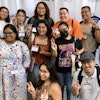Now that the debate is over about whether the U.S. Census should add
a multiracial category to its data collecting and the decision has been
made to allow respondents to choose as many racial and ethnic
classifications as they feel apply to them, the time has come to figure
out how this new and confusing information will be tabulated.
The Office of Management and Budget (OMB) has set up a year-long
task force to study exactly that: how to tabulate data from the 2000
census.
Earlier this year, the OMB announced that it will allow people to
check off as many racial and ethnic categories as they feel apply to
them on their census forms. Because some people will check more than
one category, government agencies will have to sort and interpret the
data as it relates to things like voting districts and educational
funding. That is what is causing concern among civil rights groups,
ethnic organizations, and higher education officials.
“We support the notion of self-identification, [but] we have major
concerns with the tabulation of the information and the interpretation
of information – particularly in the area of civil rights and
affirmative action,” said Eric Rodriquez, policy analyst for the
National Council of La Raza.
The OMB announced its multiple-choice decision after years of survey
testing and discussions across the country with individuals and groups
who wanted to say something about how Americans will be counted in
2000. The agency’s decision does not alter the fact that for Census
purposes, there are four racial groups – White, Black/African American,
American Indian and Alaska Native, and Asian and Pacific Islander – and
one ethnic group – Hispanics/Latinos.
The new option confuses racial counting, said Dr. Reginald Wilson,
senior scholar for the American Council on Education. He and other
observers say that no matter how many categories a person checks, they
will still have to be counted as part of only one racial or ethnic
group.
“After you’ve said you’re Korean, Mexican American, and Black, you
can’t have a person who is counted as Black, Korean, and Mexican
American,” said Wilson. “You’re going to pick one [racial or ethnic
option], or – whether you like it or not – one is going to be picked
for you.”















